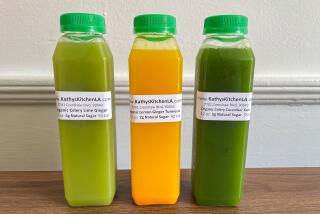Do You Juice? Notes on a Noisy Movement
- Share via
At the hour just after dawn, before the morning news shows and reruns of “Leave It to Beaver,” there they are, wide-eyed and awake on your TV screen: the perky people. Starring in their own 30-minute info-mercials, they want to improve your life . . . for just two or four or maybe 10 easy payments. They will sell you miraculous products to gloss your hair, tone your thighs, smooth your skin and fix your negative personality. But most of all, they want to sell you a juice machine.
Consider the lineup last Saturday morning. There was Jack LaLanne, the celebrity “guest” on a show called “Amazing Discoveries,” looking fit as ever at 77 and doing chin-ups around his faux-naive lug of a host to sell his machine, the Juice Tiger. “This is absolutely modern . . . this is today!” he exclaimed, as lovely wife Elaine LaLanne busily juiced out samples for the studio audience.
A few channels over, on “The Joy of Juicing,” stern Gary Null Ph.D lectured the audience on its noxious habits, while his bubbly female host chirped “That’s really good!” after every sip of juice (though she did sort of wrinkle her nose at the one that contained a hit of raw garlic). “ Six cups a day?” Null chided a hapless coffee drinker. “Do you know what you’re doing to your adrenal glands?”
Then there was the man who started the whole morning TV juice craze, Jay Kordich, known to his fans as the Juiceman. Slightly less hyper than its competitors, but no less intense, “The Juiceman Show” features lots of authoritative newspaper and magazine quotes from experts on the value of eating fresh vegetables and, just like “Nightline,” apparent satellite linkups with doctors and nutritionists who confirm that yes, juicing is good for your health.
Lately, though, the juicing phenomenon has become more than a between-channels curiosity. No longer an activity limited to health nuts and aging hippies, juicing is a full-blown trend. “Juice” is even a reflexive verb, as in, “Do you juice?” An affirmative answer may lead to a hot date--maybe a midnight shot of wheatgrass at I Love Juicy followed by a lazy Saturday morning eyeing beets at the local farmer’s market.
Just check out your local department store. A year ago you might have found a juice extractor in the housewares section, but now you’re likely to see at least four or five makes--if they haven’t already sold out.
“This is an exploding business category,” says George Whitney, vice president and merchandising administrator for housewares of Macy’s California. “It’s not as big as espresso/cappuccino makers but it’s certainly one of the hottest. It’s just growing like crazy.”
And check your neighborhood bookstore too--juice books are selling out practically as soon as they hit the shelves. “It’s taken us all by surprise,” says Mark Hill, manager of South Coast Plaza’s Rizzoli Books, a store normally known for its art and architecture books. “A good seller for us usually means 20 to 25 copies a week. But we’ve been selling 50 copies a week of the juice books.” Hill is so impressed he’s having a juice author, Stephen Blauer, who wrote “The Juicing Book,” visit the store for a book-signing on April 11.
The most successful current juice book, however, is “Juicing for Life” by Cherie Calbom and Maureen Keane. It was released in January and is already in its seventh printing, which will bring the number of copies published to 500,000. For the last four weeks, the book has been in the top 10 of B. Dalton’s trade paperback list and it has a good shot of making the New York Times bestseller list.
“Sales are stronger on the West Coast,” says Avery Publishing sales manager Ken Rajman, who handles the book, “but it’s doing well all over the country--juicing is a national phenomenon. At first it was fueled, I think, by the info-mercials. And to some extent it’s gizmo-itis. I mean, it’s fun to push carrots down a juicer with a plunger. But it’s beyond that now; it’s definitely word of mouth. People want to feel healthy.”
Not to be left out, Juiceman Jay Kordich has a book coming out next month called “The Juiceman’s Power of Juicing.” The publishing house, William Morrow, is so confident it will sell, 450,000 copies are being published in the first printing; the title is a Book-of-the-Month-Club alternate.
The Juiceman has even found his way to department stores, including May Co. and Robinson’s, in the form of the Juiceman Jr. machine, a smaller and less expensive version of the Juiceman II, sold at seminars and on TV, and the original Juiceman, now sold in health stores.
“We’ve only had the Juiceman Jr. machines in the stores since last month,” says Rick Cesari, co-founder of Trillium Health Products and JM Marketing, backers of the Juiceman machine and other nutrition-related products, “but we have firm orders for 50,000 units a month through the end of the year.”
Juicing isn’t new, of course. Back in the ‘40s, long before Jay Kordich met up with Rick Cesari, before he was the Juiceman, even before his name was Jay (his real name is John, but a TV host once misread a cue card and dubbed him Jay the Juiceman), he was drinking carrot juice--and selling juice machines.
Other early juice proponents include Max Gerson, a German doctor who set up a New York juice and natural foods clinic; Dr. Norman Walker, author of “Fresh Vegetable and Fruit Juices,” considered the juicer’s bible, and celebrity endorser of the heavy-duty masticating juicer produced by the L.A.-based Norwalk Food Co. (still on the market for about $1,200); Anne Wigmore, who got people drinking wheatgrass juice; and Dr. H. E. Kirschener, author of 1957’s “Live Food Juices,” a book full of testimonials, including one from a dog.
Only when Cesari put Kordich on TV did juicers graduate from the state-fair circuit. “We started in 1989 with four employees and did something like $900,000 in sales the first year. This year we have 160 employees and we’ll do $75 million in sales.”
David Otto, owner of the small, white-tiled Beverly Hills Juice Club, one of Southern California’s many juice bars, has been in the juice business on Beverly Boulevard since 1979. But in the past year, he’s seen an increase in new customers. There’s the woman in the motorcycle helmet and chrome Harley-Davidson purse who wants to buy a wheatgrass juicer from Otto (wheatgrass is often juiced in special extractors that release more liquid than the centrifugal juicers sold on TV). There’s the rock ‘n’ roll gofer who asks Otto, “So dude, was this juice made today? The band I work for only drinks fresh juice.” And there’s Otto’s counterman, Chuck Pennington, a ruddy-faced, no-nonsense guy, who dispenses both advice and strong shots of wheatgrass to a steady stream of regulars.
At the Tina Cassaday Salon in Beverly Hills, fruit juices go into the shampoos and conditioners--and in glasses dispensed from the black marble juice bar. Juice has even hit the world of haute cuisine. At the very hot New York restaurant, Jo Jo, chef Jean-Georges Vongerichten uses raw juice as the base for several sauces. He got the idea after drinking a glass of carrot juice.
“Other chefs have used vegetable sauces before,” Vongerichten says, “but they cooked the vegetables and then pureed them. I find raw juice works best--later you heat them up and add different spices.”
He might serve a warm, fresh goat cheese salad in a puddle of arugula juice, sea scallops in zucchini juice or shrimp in spicy carrot juice. In his recent book, “Simple Cuisine,” he devotes a whole chapter to sauces made with raw juice.
But don’t count on Vongerichten for health advice--his theories aren’t exactly in sync with nutritionists:
“If you just drink carrot juice it goes right through your body,” Vongerichten insists. “But if you add a little fat--a little butter or bit of oil--the vegetables and minerals really stick with you.”
More to Read
The complete guide to home viewing
Get Screen Gab for everything about the TV shows and streaming movies everyone’s talking about.
You may occasionally receive promotional content from the Los Angeles Times.







